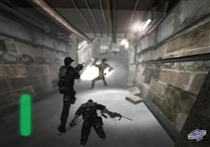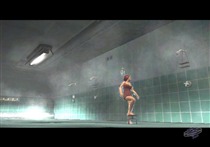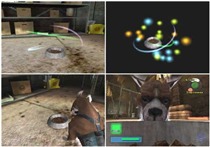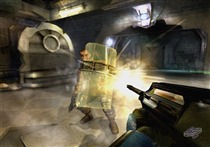We sat down with n-Space's Dan O' Leary and Ted Newman and talked about the company, the challenges of game development and the future of upcoming projects.

On the company…
Nintendo World Report (NWR): Can you explain our readers your role at n-Space?
Ted Newman (TN): At n-Space I act as Studio Creative Director, which means I try to get involved with every project in development and help out by providing feedback on everything from gameplay to graphics to performance and mechanics. How involved I get depends on the state of the project and the needs of the team. Usually I only get to sit down and play each title every month or so – which is actually nice because I don’t see it day in and day out like the team. So in that respect I provide an outside viewpoint that is looking at the game with relatively fresh eyes. At times I’ll get involved with projects that are in preproduction, helping during the formative process of the design. We also do a fair amount of concept pitches and proposals at n-Space, so I’m often involved in writing or reviewing those documents.

On Geist…
Geist is a cult favorite among our readership, and was recently revisited in the RetroActive segment of our flagship podcast, Radio Free Nintendo.
NWR: How did n-Space first come up with the idea for Geist?
TN: At the 2001 E3, Dan and Erick met with a representative from Nintendo of America as part of a simple introduction, during which they were told that Nintendo would be interested in a First-Person shooter with a twist. When Dan and Erick got back from the show, a small group was assembled to generate some ideas. An early favorite revolved around the concept of the player being invisible and on the run. Not only could this character pick up a gun and fight back, but he was also capable of messing with people and scaring the hell out of them since he couldn’t be seen. We liked the idea but ultimately it needed something more. That’s when someone said, “Well what if you’re a ghost? And the way you use weapons is by possessing someone who is armed?” It was one of those “Eureka” moments and we ran with it from there.
NWR: Geist was first shown at E3 2002, but wasn't released till 2005. Can you tell us a bit more about the development of the title?

TN: After coming up with the concept, we spent some time quickly developing a demo that ran on a PC using our existing engine. The demo was very sci-fi in nature, taking place on a space station with these Star Trek look panels and enemies armed with laser weapons. But the core was there – a ghost that could frighten and possess people to use them as tools and weapons.
We shopped that demo around to a variety of publishers and actually started production with Namco under the name “Fear” (this was before anyone had ever heard of that other game called “Fear”). We worked with Namco for about 4-5 months on pre-production but, partway through development, there were some changes in producers and some resulting differences of opinion when it came to what the game should be about. We parted ways amicably and took the game back on the road to shop it around again.

That’s when Nintendo of America (who had seen the first demo) took notice and introduced us to NCL (Nintendo of Japan). NCL loved the idea and the new demo, but their biggest question was actually related to multiplayer. “What could we do with this idea of possession when it came to multiplayer?” NCL funded a 3-month “experimental phase” where we focused on nothing but possession-based multiplayer, which we demonstrated for them personally in Kyoto to an audience including Miyamoto-san, Tanabe-san, and Konno-san. The reception was great and before we left we were told that Nintendo would fund the game. That kicked us off into full production of a game which was now a single player title with an added multiplayer mode. We worked closely with Konno-san (our NCL producer) and his small team for the first half of development and Tanabe-san towards the end.
We soon found that Nintendo has a very different way of working on a game like Geist. If there’s an aspect that really interests them – possession, for example – they’ll want to essentially focus on that one piece, experimenting with it and bringing the mechanics and effects and art to a polished state so they can really touch and feel it in the game. In some ways this is great because you can really develop some cool ideas in the process and get a clear picture of major mechanics, but ultimately it makes production very difficult because you have an entire team of programmers, designers, and artists that needs to move forward and can’t all be working on this one element of the game. That approach was something we had to adapt to and work around. As a result we became very nimble when it came to taking feedback and turning around quick changes to try out in the game.
About halfway through production, we had the major curveball of “object possession” thrown at us (it’s a story we’ve told before but I’ll recap it here). Like any other major Nintendo title, Miyamoto-san was involved with Geist from time-to-time and at one point had mentioned to his team at NCL that he was curious about what it would be like to possess an object like a plant or a crate. Up until then, we were only possessing people and animals. His co-workers actually thought he was kidding (something Miyamoto-san does) and they never brought it up with us – until one visit in particular. They apologized for not mentioning it sooner but wanted us to talk about possessing objects and how that would factor into the game. The rest of that visit was focused on this new mechanic, how we could make it interesting and fun, and how would it impact all the work done so far. That was a big change for us and something that helped steer us down the path of being more of a First-Person Adventure than a Shooter.
As we neared the end of the title, something Tanabe-san felt strongly about were Boss Battles – something that wasn’t at all in our original design. We had some larger fights and tougher enemies planned, but nothing that really fit the Nintendo definition of a Boss. Developing roughly 7 new Bosses certainly added time to the schedule, but fortunately some of those ended up being highlights of the game that really showcased our unique mechanics.

NWR: Looking back at Geist, what aspect of the game are you most proud of? What do you wish you could have improved upon?
TN: When we set out to make Geist, our goal was to take a genre like First-Person Shooters that had been done time and time again and do something truly different with it. Along the way, Geist morphed into more of a First-Person Adventure game, but the original core of being a ghost that possesses people, animals, and things was still there and still something the player hadn’t experienced before. That’s something we’re really proud of – bringing something fresh and original to the market.
As for what to improve upon, as with any game you can always think of numerous parts you would love to go back and polish up. But I’d say the combat AI ranks up there as something we wish we had spent more time improving upon. There are some fun battles in the game but overall we wish the general AI had been a little more sophisticated in firefights. We spent a good deal of time trying to develop AI that could respond to a multitude of situations, including being attacked by their own ranks or responding to a variety of possessed objects and ghostly influences – but in the process their behavior in general combat could have used more attention.
NWR: What lessons from Geist have you applied to subsequent n-Space projects?
TN: Geist taught us a lot about managing scope in a project. There were so many ideas flying around during development when it came to being a ghost and possessing people, animals, and things that it was tough to nail down what was most important – those few mechanics that make up the core gameplay which we could polish to perfection and make the strongest title possible. When developing our games now, we try to hone in on those core ideas as early as possible and make sure they are always in the forefront of the schedule and our designs.
NWR: Would you ever return to Geist and create either a remake or a sequel?
TN: Absolutely. It was a long, tough project but one that we learned a lot from. It was also the first time we had collaborated with Nintendo, and that came with its own set of challenges since our concept of a “ghostly first person shooter” differed from theirs, so a good deal of time was spent finding that common ground. But in the end they were excellent partners and we learned a lot together. We would love to go back to Geist and the concept of ghosts and possession, either as a remake or an expansion of that universe. It’s flattering and gratifying to know that Geist has something of a cult following. We worked so hard on this game so we hope it finds a way to live on.

On Winter…
NWR: The Winter tech demo has impressed a lot of gamers. Any word on its development status?
TN: Well we can’t avoid the pun, but any development on Winter has been frozen for the time being. We created an updated demo back in March ’09, applying some of the new technology and techniques used in our maturing Wii engine, and that version piqued the interest of a few publishers around the time of GDC ‘09. But it still comes down to the same dilemma of publishers being adverse to taking that risk and funding a hardcore Wii game that’s also a brand-new IP. Winter is still something that a lot of n-Spacers are passionate about and would love to work on, so it comes down to a publisher showing interest and us having a team ready to take it on. Of course, it doesn’t hurt to have the press and fans spread the word and show their desire to see Winter developed.

NWR: How does Winter use the Wii's unique motion sensing technology?
TN: At the time we created the demo, there were a lot of gimmicky and unnatural things being done with the Wii controller in existing games. It seemed like developers were still trying to grasp what to do with Wii in general (and, in a lot of ways, still are). Our goal was to do what felt right and made sense. That said, our mechanics were very simple. Pinch A+B to grab something. Lift the controller up to lift the hood of a car. Pull it back to open a drawer or cabinet. Swing it this direction to attack or jab it forward to stab. Shake it to jostle the batteries inside your flashlight. Basic-yet-natural stuff.
When the tech for the Wii Motion Plus became available, we created some mechanics in the updated demo that use the 1:1 ratio you could achieve between the Wii Remote and an object onscreen. We had started thinking of ideas where the angle of the object you were using would really matter. For example, if you needed to use a crowbar to pry off a piece of wood that was nailed to the wall, you had to get the angle of the Controller just right to wedge the crowbar in and give it a yank, otherwise you would just be splintering the edges of the wood. Or if you were using the flint striker to light a fire (seen in the demo), you had to turn the controller over and upside down to get the sparks falling directly on the oily rag. We wanted the player think about things working in the game the same way they would in the real world.

NWR: How was Winter first conceived?
TN: Winter started as a simple experiment really. A few of us were discussing what types of games we’d like to see on the Wii. The idea of creating an old school Survival Horror game came up – how the genre had really strayed from its roots over the years and how the Wii Remote would be perfect for all kinds of immersive mechanics that would apply to a survival horror title, like using a flashlight, swinging a blunt object, opening drawers and cabinets, and so on. That style of game would also allow us to restrict the camera, letting our artists pump in much more detail where we wanted to create the best looking Wii game out there.
At the time we had a few people available so we took our engine and designed and built the earliest Winter demo where the player controls the Mia character in this abandoned town, using the Wii Remote to interact with a variety of objects, aim her flashlight, and swing blunt objects for defense and attack. It showed a lot of potential, enough for us to take it one step further. That’s when we added the concept of snow and freezing temperatures. We latched onto the idea of survival not just involving monsters but also the elements themselves. This opened the door for all kinds of puzzles where the player is simply trying to create heat and stay sheltered in order to survive.
NWR: Thank you Ted for taking time from your busy schedule to chat with us!
TN: No problem at all! It’s great to reflect on some past projects that are near and dear to my heart – and it makes me very happy to see that people are still talking about them. n-Space has been my one and only job in the games industry (14 years and counting) and I can’t imagine a better home to create and play in.